#evernia mesomorpha
Text
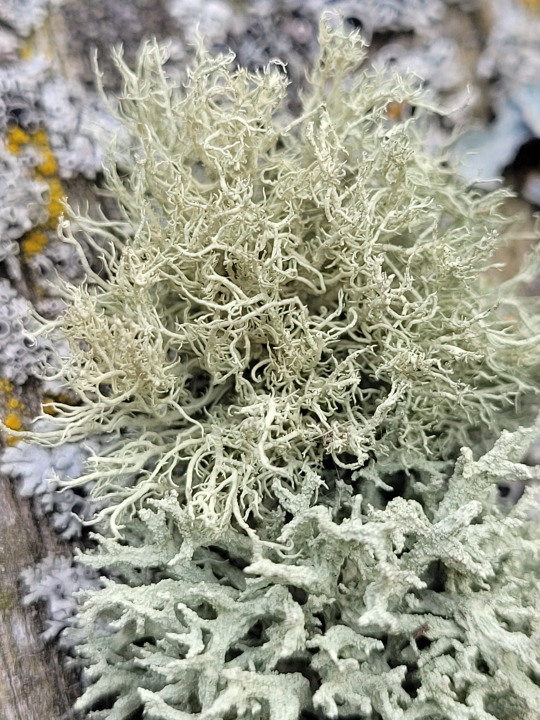
Usnea sp. (top) & Evernia mesomorpha (boreal oakmoss, bottom).
South of Saskatoon, SK, Canada. June 3, 2023.
4 notes
·
View notes
Photo
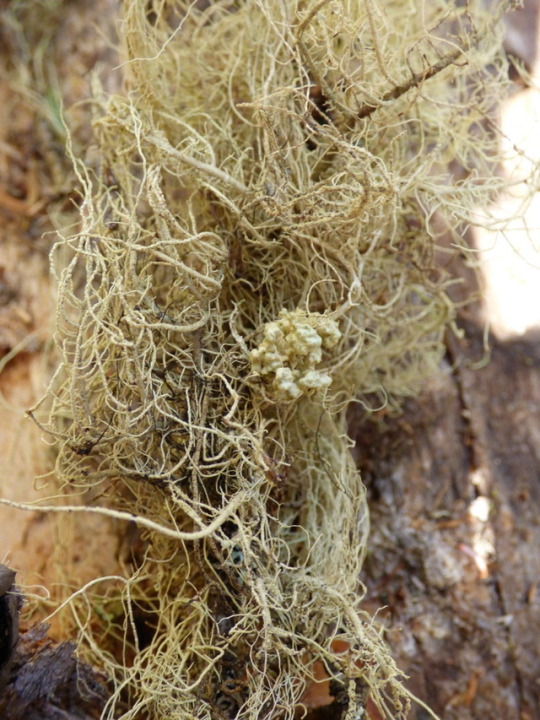
Preface
Yes, this post is long enough to require a preface.
As promised, this is the extent of the world’s knowledge on Tremella everniae, gathered from the literature and an interview with Veera Tuovinen, a grad student who does research on this species. This was originally written as an assignment for my Fungi course where I had to make a wikipedia-style page about a species, and now I’m sharing it with y’all to celebrate getting an A+ in the course AND a job working with my prof this summer!
Tremella everniae
Binomial name: Tremella everniae Deiderich
English name: none
Classification
Phylum: Basidiomycota
Class: Tremellomycetes
Order: Tremellales
Family: Tremellaceae
Genus: Tremella
Species: Tremella everniae
Description
Tremella everniae is a lichenicolous Basidiomycete fungus thought to be parasitic on the Ascomycete lichens Evernia mesomorpha, Evernia prunastri, and Evernia esorediosa. The only structure currently described is its fruiting body or basidioma, which is a popcorn-like gall formed on the host. The basidioma is 3-15mm in diameter and is initially the same grey-green colour as the host, then develops a brownish hymenium at maturity. The interior of the basidioma appears white and fluffy, and contains hyphae of both T. everniae and the host fungus, algal cells, and basidia and basidiospores of T. everniae.
Tremella everniae is a heterobasidiomycete. Heterobasidiomycetes are a polyphyletic group characterized by basidiospores which can germinate by means of secondary spores, basidia that are are often septate, and being saprophytes or parasites on other fungi or on plants. The genus Tremella is not a monophyletic group, so T. everniae has little in common with jelly fungi also included in this genus.
Life Cycle
Tremella species are generally all dimorphic, having a hyphal teleomorph and a yeast anamorph. Although only the fruiting body of the hyphal phase has been described in T. everniae, it is assumed that this species is dimorphic and has a yeast phase as well. It is hypothesized that the yeast phase may be found in the cortex of the host lichen.
There are two phases of the dimorphic life cycle, haploid yeast and dikaryotic mycelium. The yeast cells conjugate to form the mycelium, which then forms the fruiting body, which produces basidiospores that give rise to more yeast cells. The mycelium may also produce conidia which give rise to yeast cells.
Ecology and Distribution
Tremella everniae can be found on the lichen Evernia mesomorpha. It has also been found on the lichens Evernia prunastri in Europe and Evernia esorediosa in northern Asia.
The exact distribution of T. everniae is unknown but assumed to be the same as that of its host lichens. E. mesomorpha is found over conifers in open boreal forests at lower elevations. E. prunastri is found over coniferous and deciduous trees and shrubs in sheltered, humid forests at lower elevations. Both host lichens are incompletely circumpolar.
In Alberta, T. everniae can be found in the boreal forest.
Parasitism
Tremella everniae is thought to be mycoparasitic on the fungus in its host lichens. Almost all Tremella species are mycoparasites, and so it is assumed that the same is true of T. everniae. However, because the genus Tremella is polyphyletic, its species may bear little resemblance to each other. T. everniae has lots of haustoria, the structures known to be used by parasitic fungi to extract resources from their hosts, however the presence of haustoria is not necessarily evidence of mycoparasitism. It is unknown whether the haustoria of T. everniae actually penetrate the host cells. Additionally, some assume that the presence of galls is automatically an indication of disease, however this has not been proven.
Future Research
Very little is known about Tremella everniae! Future research could focus on locating the yeast phase, and determining the exact nature of the relationship between T. everniae and its host lichen. It would also be valuable to determine the phylogenetic relationships within the polyphyletic genus Tremella in order to make valid comparisons between species.
Gallery
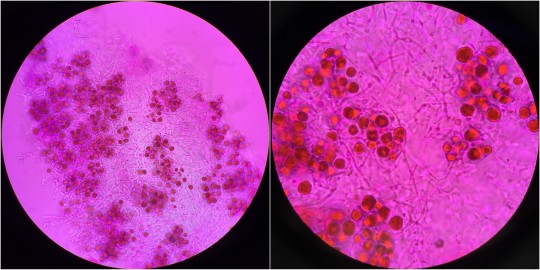
Left: Cross section of Tremella everniae fruiting body stained with phloxine and viewed at 40x magnification. Note the algal cells (large red circles) and fungal hyphae (squiggly lines). Right: Cross section of Tremella everniae fruiting body stained with phloxine and viewed at 100x magnification.
References
von Brackel, W. and D. Puntillo. 2016. New records of lichenicolous fungi from Calabria (southern Italy), including a first checklist. Herzogia 29(2):277-306.
Diederich, P. The Lichenicolous Heterobasidiomycetes. Bibliotheca Lichenologica 61.
Goward, T. 1999. The Lichens of British Columbia: Illustrated Keys, Part 2 - Fruticose Species. Crown Publications, Victoria, British Columbia, Canada.
Liu, X.-Z., Q.-M. Wang, M. Göker, M. Groenewald, A. V. Kachalkin, H. T. Lumbsch, A. M. Millanes, M. Wedin, A. M. Yurkov, T. Boekhout, and F.-Y. Bai. 2016. Towards an integrated phylogenetic classification of the Tremellomycetes. Studies in Mycology 81:85-147.
Millanes, A. M., P. Diederich, S. Ekman, and M. Wedin. 2011. Phylogeny and character evolution in the jelly fungi (Tremellomycetes, Basidiomycota, Fungi). Molecular Phylogenetics and Evolution 61:12-28.
Zhurbenko, M. P. and S. E. Vershinina. 2014. Opegrapha bryoriae sp. nov. and other lichenicolous fungi from Asian Russia. Herzogia 27(1):93-109.
Zugmaier, W., R. Bauer, and F. Oberwinkler. 1994. Mycoparasitism of some Tremella species. Mycologia 86(1):49-56.
#fungi#fungus#lichen#lichens#mycology#science#tremella#tremella everniae#evernia#evernia mesomorpha#evernia prunastri#evernia esorediosa#lichenicolous fungus#mycoparasitism#lichenology#not plants
29 notes
·
View notes
Photo

Evernia mesomorpha
Boreal Oakmoss, Ring Lichen
(via)
8 notes
·
View notes
Text









Evernia mesomorpha
Boreal oakmoss lichen
My favorite smell in the world might be the smell of Evernia. It has this delicate, earthy aroma that is unparalleled. When I am lichen collecting, I love to stick my face in my lichen bag and get a whiff. If you ever come across some like E. mesomorpha, I recommend you give it a sniff. You'll find this particular gem in cold, coniferous forests, growing in fruticose tufts on the bark of trees. It has a light yellow-green thallus often covered in concolorous soredia. The branches are thick, irregular, wrinkled, and flexible! Plus Evernia mesomorpha sounds like a cool DnD spell I could use to turn myself into a lichen, so there's that.
images: source | source | source | source
info: source | source | source
#lichen#lichens#lichenology#lichenologist#lichenized fugus#fungus#fungi#mycology#ecology#biology#botany#bryology#systematics#taxonomy#life science#environmental science#natural science#nature#naturalist#the natural world#beautiful nature#weird nature#Evernia mesomorpha#Evernia#oakmoss#I'm lichen it#lichen subscribe#daily lichen post#lichen a day#go outside
59 notes
·
View notes
Text
A Lichen for Alberta
Birds, stones, trees, grass… Alberta has an official emblem of each. https://www.alberta.ca/alberta-emblems.aspx
What about the humble but incredible lichen? Troy McMullin, lichenologist at the Canadian Museum of Nature, is coordinating lichen lovers in each region of Canada to nominate provincial and territorial lichens. Inspired by last year’s competition to nominate a national bird by the Royal Canadian Geographical Society (Grey Jay) this isn’t an official petition. Just a fun way of bringing awareness to the awesome lichens that inhabit Canada.
So what exactly is a lichen? You know that Spiderman character Venom, who is a symbiote between a human and an alien? They are kind of like that! Well…. Sort of… Lichens are a symbiotic relationship between fungi and algae. Together those partners transform into what we call lichens. Lichens form a myriad of shapes, colours, and sizes, and live in every natural region of Alberta. That orange stuff on trees in the city? That’s lichen. The brown ‘hair’ hanging from trees in the mountains, the bright yellow powdery lobes on logs, the tiny pyxie cups on the forest floor – all lichens!
Professional and amateur lichenologists from around Alberta have narrowed the list from the more than 1,000 species found in our province to six finalists for Alberta’s our Provincial Lichen. Learn a little about each below, then visit our Facebook page ( http://bit.ly/2RYRTH6 ) to vote for the lichen you think best represents our province!
First up!
#1

Flavopunctelia flaventior
Common Name: Speckled Greenshield Lichen
This lichen is large and leafy, minty green and lives on trees. Speckled Greenshield Lichen is the more common of two species of Flavopunctelia in Alberta. Look close for its diagnostic small white dots (called pseudocyphellae or “fake-windows”), and small patches of grainy powder (called soredia) on the surface of its lobes. The soredia are a mix of algae and fungal threads that can be carried by rain, birds or insects; if they land in the right habitat, they’ll start a new lichen. In Alberta, this lichen can be found in every natural region, including urban areas in the Parkland natural region. That doesn’t mean this lichen isn’t sensitive. Our activities decrease this species’ abundance through loss of habitat.
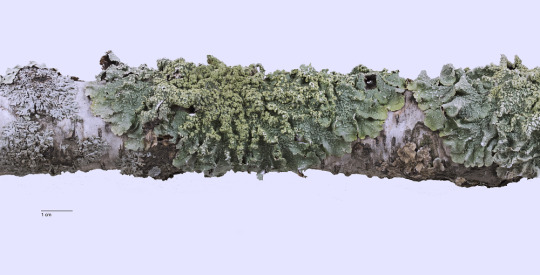
It grows on trees such as aspen, poplar and birch and occurs across southern Canada. It is most widespread in Canada in Alberta and Saskatchewan.
Fun fact: When you touch a bit of bleach to the cottony fungal threads inside the lichen, you’ll get a pink chemical reaction, making this species great for novice lichenologists to try their hand at using chemistry for lichen identification.
Why should it be Alberta’s Provincial lichen? Its beauty, its ability to inhabit and brighten up urban parks, and its distribution across Alberta where it is limited in most other regions of Canada.
Nominated by: Darcie Thauvette, Lichenologist
#2

Letharia lupina
Common Name: Mountain Wolf Lichen
Wolf lichens (Letharia species) are bright yellow tufts that are hard to miss, especially in winter against a backdrop of snow. Wolf lichen is now understood to be two species, and, in Alberta, we have the more common Letharia lupina, whereas L. vulpina occurs further west and south. Mountain Wolf Lichen is tufted with rough branches covered in patches of grainy powder (called soredia, made of fungal threads and algae).
Mountain Wolf Lichen is an iconic montane species in Alberta, growing most abundantly in the Rocky Mountains, and Foothills. Rarely it also can be found in the southern Parkland and Grassland natural regions. It is most abundant on spruce and pine in conifer-dominated forests.
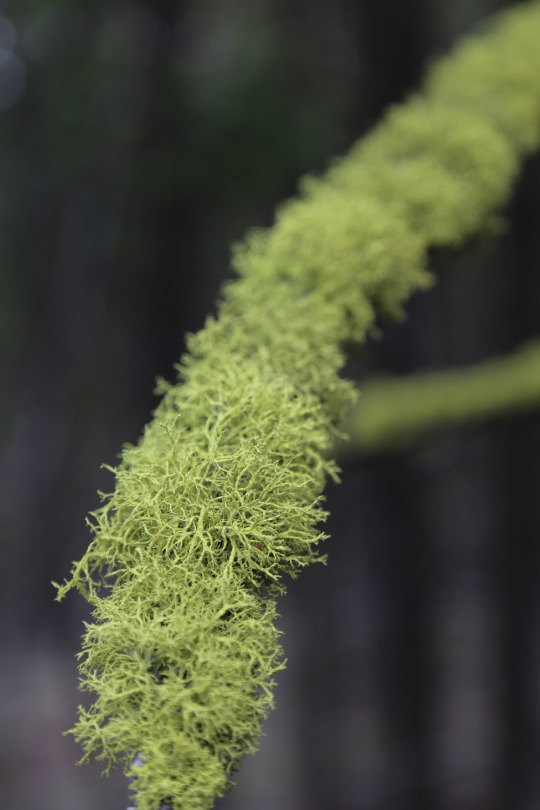
Fun fact: Or not so fun in this case. You know the old saying, don’t eat yellow….lichen!? The bright yellow colour of Wolf Lichen is from a chemical the lichen makes called vulpinic acid. This acid is poisonous. In part of Northern Europe this lichen was mixed with fat and glass shards and placed with bait to kill wolves. ‘Lupus’ is Latin for ‘wolf’. Extra extra! Scientists at the University of Alberta recently showed that Wolf Lichens are made of a team of not 1, not 2, but 3 types of fungi!
Why should it be Alberta’s Provincial lichen? Its colour and beauty, its association with the world-renowned mountains of Alberta, its limited range in most other parts of Canada, and finally its complexity - because we’re a complex and diverse province.
Nominated by Peter Josty, Executive Director, The Centre for Innovation Studies, and Mari Decker, Senior Vegetation Ecologist
#3
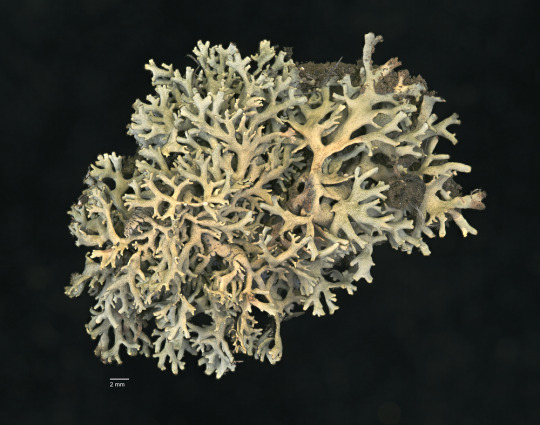
Xanthoparmelia camtschadalis
Common Name: Vagabond Rockfrog Lichen
Vagabond Rockfrog is perhaps the most charismatic and elegant of Alberta’s Xanthoparmelia. Vagabond Rockfrog typically is toonie sized, forming larger colonies when the site is right. Its lobes are slender and evenly branching; its colour is pale greenish yellow with white mottling, almost as if it was sponge-painted with watery, white paint. Keep your eyes on the ground in a prairie or well-managed pasture, and you’ll usually find this lovely lichen loosely attached to soil or resting on top of Prairie Selaginella (Selaginella densa) and Pixie-cup lichens (Cladonia spp.).
Vagabond Rockfrog Lichen is most common in the Grassland natural region but also can be found in the Rocky Mountain region. In Canada it appears to be most common in our province, with additional collections from Saskatchewan or more rarely British Columbia.
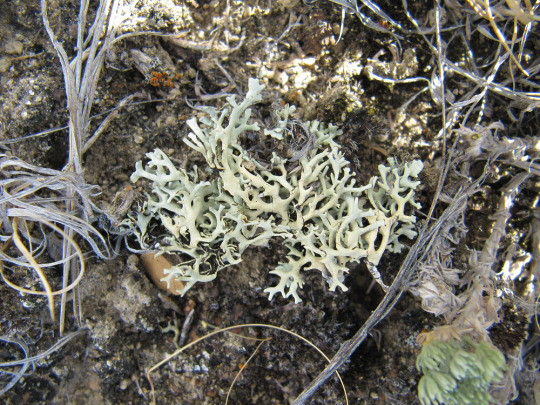
Fun fact: This lichen got its Latin name from the region it was first described from, Kamchatka, Russia. It is part of a living soil crust community that fixes carbon and nitrogen from the air, stabilizes soil, helps absorb water, and perhaps even forms a barrier to some invasive weeds.
Why should it be Alberta’s Provincial lichen? Its beauty, its association with the historically and economically important grasslands of Alberta (Alberta beef anyone?), and its limited range in other parts of Canada. Most Albertans live and work in the natural regions that historically supported prairie and aspen forest mosaics, the Grassland and Parkland. Provincially, native grassland has declined, which has also reduced quality habitat for grassland lichens. Grassland lichens are under-appreciated and under-studied - choosing a grassland ambassador could raise awareness.
Nominated by Lysandra Pyle, Rangeland Ecologist
#4
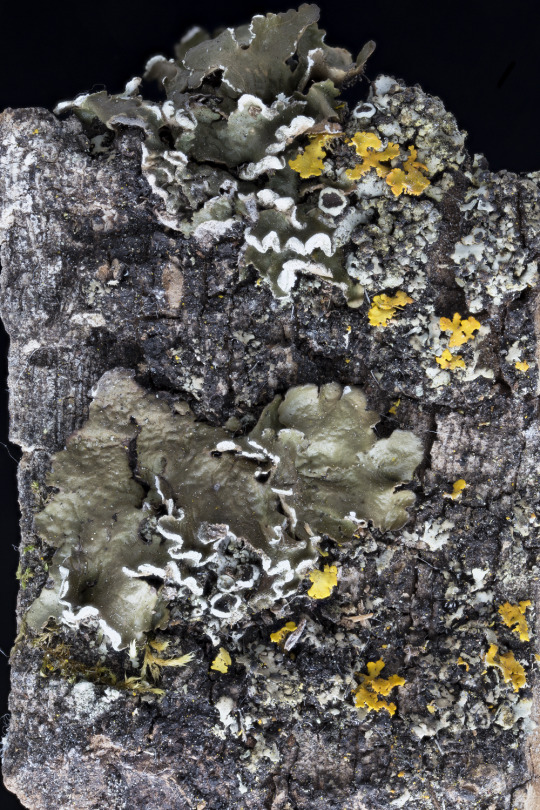
Melanelixia albertana
Common Name: Powdered Camouflage Lichen
First described from Alberta 50 years ago, Melanelixia albertana shares our province’s name. Melanelixia albertana is not in-your-face, and tends to camouflage with its olive-green color. Look on deciduous tree bark, especially poplar trees, for a leafy lichen 4 to 10 cm wide with rounded lobes and little white powdery ‘lips’ (called soralia). The skin of Powdered Camouflage Lichen is often shiny, almost oily, in appearance.
Powdered Camouflage Lichen is found in every natural region of Alberta, most commonly in the Boreal and Parkland. But don’t worry about going far to get a look; Melanelixia albertana can be spotted in urban centres, including Edmonton’s river valley. Within Canada, Melanelixia albertana is limited to the west with most collections found in Alberta, Saskatchewan, and Manitoba. Definitely, something to brag about to your friends out east!

Why should it be Alberta’s Provincial lichen? Ok – it’s not yellow. But beauty is in the eye of the beholder, right! This species is named for Alberta, and current data suggests it is more abundant in Alberta than anywhere else in the world. The ‘smelly Melies’ are typically a genus of hard-to-identify brown leaf-like lichens. But Powdered Camouflage Lichen makes it easy (sort of) with its lip-shaped soralia - just like Alberta, it is unique amongst its compatriots. And finally, there’s that oily sheen – need we say more?
Nominated by Laura Hjartarson, BSc, and Derek Johnson, Botanist & Forest Ecologist
#5

Evernia mesomorpha
Common Name: Boreal Oakmoss Lichen
Picture Einstein’s hair – only greener and thicker - that’s Boreal Oakmoss Lichen. Pale greenish-yellow, tufted and shrubby species, this lichen is found on trees of all sorts in sunny forests throughout Alberta.
Boreal Oakmoss occurs in every natural region of Alberta, most commonly in the Boreal and Foothills forested regions. However, it is a hardy species and will pop up in the grasslands on soil, rocks and fence posts.
Fun fact: This lichen has a long history of human use, particularly in Europe where thousands of tons of Evernia are collected and ground up as a perfume fixative (while it is abundant here, it’s not abundant enough to do that in Alberta!). It is also tolerant of people, and while most shrubby lichens struggle in the city, Boreal Oakmoss Lichen can be found in Alberta’s urban river valley parks.
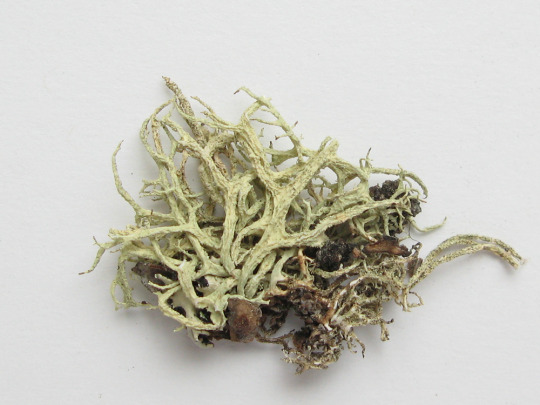
Why should it be Alberta’s Provincial lichen? This is a hardy northern species (like Albertans) that thrives across much of Canada. However, it prefers Alberta to British Columbia and its range is mostly restricted to east of the Rocky Mountains.
Nominated by Sandra Davis, Botanist
#6

Icmadophila ericetorum
Common Name: Spray Paint Lichen
Spray Paint Lichen is aptly named – it’s easily recognized as a splash of mint green dotted with pink ‘buttons’ (actually the spore-bearing structures, called apothecia, of the lichen). Spray Paint Lichen is a crust lichen, that is, its ‘body’ is limited to a thin layer of algae and hyphae growing intimately attached to whatever it is growing on.
Spray Paint Lichen grows on damp moss, rotted wood and soil, and can be found in every natural region of Alberta. It is most common in the mountains and bogs of northern Alberta.
Fun fact: This lichen has a few common names, including Candy Dot and (ahem) Fairy Puke. No matter what you call it, this lichen is a showstopper.

Why should it be Alberta’s Provincial lichen? This is a fun, charismatic crustose lichen that is easy to identify and occurs across much of Alberta. It also draws attention to two of our iconic environments, the Rocky Mountains, and the bogs of northern Alberta that play a critical role in water retention and filtration. It is also the only species of the genus found in North America.
Nominated by Derek Johnson, Botanist & Forest Ecologist, and Diane Haughland, Lichenologist
Pretty cool huh?
Update: Jan 29, 2019 - Voting closed on January 27th, but keep an eye on our Facebook ( http://bit.ly/2RYRTH6 ) page for an announcement of the winner!
2 notes
·
View notes
Text
lichen people:
Can anyone point me in the direction of some lichen resources? specifically on Tremella everniae and/or Evernia mesomorpha.
@botanyshitposts sorry to single you out but you seem to know things about lichens
#not plants#lichen#lichens#mycology#lichenology#tremella#tremella everniae#evernia#evernia mesomorpha
36 notes
·
View notes